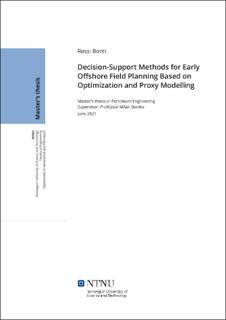| dc.description.abstract | Field development planning is an essential phase in the life of an offshore field as many vital decisions, such as type of platform, production and drilling schedule, and capacity of processing facilities, are made during this stage. To address these challenges, SUBPRO, a research center for subsea production and processing, and BRU21, a research program on digitalization and automation solutions for the oil and gas industry, performed research to develop automated methods to provide decision-support in early field development.
This thesis picked up and continued the specialization project work of Bonti (2020). In the work of Bonti (2020), non-linear programming (NLP) optimization model was developed to determine drilling and production schedules and capacity of processing facilities that maximize project net present value (NPV). All wells were considered identical and part of a subsea network. This thesis studied the effect of uncertainties on the optimization results and developing and testing methods to determine the best field design considering such uncertainties. The effect of uncertain parameters such as initial oil in place, cost factor, well performance, and oil price was studied using simulation-based optimization and the Latin Hypercube Sampling (LHS) method.
Several field design methods using the results of the LHS simulations were tested, i.e., drilling schedule and processing capacities were selected using several criteria. The performance of the resulting design was then tested by repeating the LHS study but optimizing the production profile only and compared against the original results of the LHS. The analysis using the LHS method also evaluated the effect of 1) relaxing the upper bound in the number of producer wells allowed and 2) considering flexibility in the drilling schedule by having wells that can be "optional" to be drilled or not. The study showed that the base uncertainty model utilized an adequate number of producer wells (9). On the other hand, the inclusion of wells that are optional to be drilled or not significantly decreased the percentage difference of the NPV figures with respect to the base simulation results.
Stochastic programming (SP) was also employed to determine the optimal field design considering uncertainties. However, due to its computational complexity, it was not possible to include all uncertain parameters evaluated in the LHS. The optimal field design using the SP and the best methods based on the LHS results are very similar and have similar economic performances. Due to the complexity and the high running time required by the SP model, it is therefore recommended to use a design method based on LHS.
Lastly, the non-linear model was improved by including the distinct well performance in the production performance model and pipeline length in the cost model. The results and the computational performance of the revised model were compared against the model of Salma (2020), who employed piecewise linearization (PWL) using SOS2 variables instead of a non-linear formulation. The comparison showed that both models produced almost identical drilling schedule, production profile, and NPV figure. However, the non-linear model was superior to the linear model in running time, with 1.8 seconds compared to 21544.5 seconds. Therefore, the non-linear model seems to be a superior modeling and optimization approach to the PWL formulation. | |
